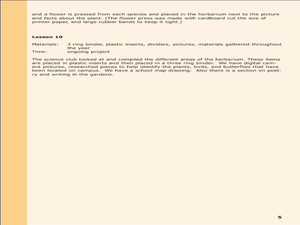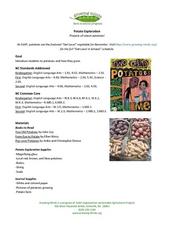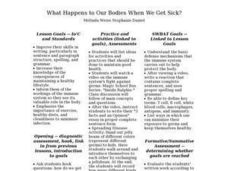Curriculum Corner
Guest Teacher Plans (Grade 2)
Be prepared the next time you're in need of a substitute with a daily plan equipped with an assortment of activities covering subjects math, reading, word work, writing, and science.
MENSA Education & Research Foundation
Hurricanes
Learn the ins and outs of hurricanes through a series of lessons answering, "What is a hurricane? How does it travel? How is one formed, measured, and named?" Information is presented through informative text and images, while...
PBS
Reading Adventure Pack: Bees
A Reading Adventure pack explores the busy life of bees. After reading a fiction and nonfiction text, scholars complete three hands-on activities. Participants invent a robot that can do the work of bees, cheers to hardworking bees with...
American Museum of Natural History
Journey to Deep Sea Vents
Take a deep dive into oceanography. The online interactive allows for learners to board a submersible to dive to the bottom of the ocean to investigate sea vents. On the way down, individuals see different marine life at different...
Curated OER
Mitosis Cookies Activity
Reward biology learners for working hard in their mitosis lesson with a sweet snack at the end! They begin by twisting apart creme-filled cookies and using the icing as a cytoplasm. Colored candy sprinkles make up chromosome pairs,...
Curated OER
Types of Behavior: Animal Behavior Research
How does one determine what influences animal behavior; Is it nature or nurture? After a short reading explaining different types of conditioning and other learned behaviors, scholars examine six scenarios to determine whether the...
Curated OER
River of Venom
Read an exciting science mystery about killer bees online, evaluate a list of clues, and try to answer the questions correctly. The story responds to the reader's choices and presents research material for the next step. Though the...
Kenan Fellows
Designing a Water Treatment Plant
How does dirty water get clean enough to drink? After viewing a PowerPoint that outlines the process water goes through at a water treatment plant, groups work together to design a chlorination chamber for a treatment plant.
Curated OER
Nature Oriented Kindness Projects
Students complete various nature activities where they work together to create a butterfly garden, plant flowers, learn about nature survival, and more. In this nature lesson plan, students work together in groups and display kindness...
Curated OER
Bodies in Motion
High schoolers work in teams and train in the methods of anthropometry, the measurement of the human body. These activities require calipers or measuring tapes, meter sticks, skin fold calipers, and human skeleton.
Curated OER
Cooperative Learning
Learning can be structured competitively, so that students work against each other; individually, so that students work alone; or cooperatively, so that students work together to accomplish shared learning goals.
Curated OER
Images of Science
Students understand the diversity of science, both in terms of the work and the people engaged in the work. They learn that some scientists and engineers use huge instruments (e.g., particle accelerators or telescopes), and others use...
Curated OER
Taking Care of Pets
Students and teacher discuss having pets such as dogs and/or cats, etc. They then read a book about pets and listen to a veterinarian visit with the them about their work and taking care of animals.
Curated OER
Spark of Imagination
Learners consider the power of physics. For this current events lesson, students listen to a lecture that explores the power garnered by iPod batteries and how they work.
Royal Society of Chemistry
Acids and Alkalis
Is your acid-base chemistry lesson plan a little ho-hum? Spice things up with puzzles! Young chemists manipulate facts about acids and bases to solve a series of interactive puzzles. The activity combines content knowledge and...
Curated OER
Learning About Magnets
Students discuss which objects attract magnets and which ones will not. They work in small groups to to discuss the concept of magnets and why certain objects attract magnets and some don't and then they experiment with them.
Curated OER
Name that Natural Resource
Students discuss natural resources. In this science lesson, students understand that physical properties can be used to identify minerals and complete the chart each day working alone or in a small group.
Growing Minds
Potato Exploration: Projects All About Potatoes!
How many potatoes tall are you? Unearth this rich resource! A reading of John Coy’s Two Old Potatoes begins a cross-curricular exploration of potatoes. Class members read, write, weigh, measure, and experiment with potatoes. Additional...
K12 Reader
The Scientific Method
Introduce the scientific method with a reading comprehension activity. Have kids read a few paragraphs that describe the process of making a hypothesis, gathering evidence, and taking notes that will support the experiment.
Curated OER
Circulatory and Respiratory Systems
Students are taken to a shady location and they seat in a large circle. They are given three questions each. Students research and answer the three questions. They summarize the circulatory and respiratory system and relate how they...
Curated OER
Hatching Chickens
Students observe chickens hatching in a classroom incubation environment In this egg-hatching lesson plan, students make observations of the hatching process and later care for the hatched chickens.
Curated OER
Weather Lesson
Students discuss the weather conditions. They read thermometer, rain gauge, barometer, and wind direction and speed. They record observations of weather conditions and enter information into data base on the computer.
Curated OER
What Happens to Our Bodies When We Get Sick?
Seventh graders explore ways in which they become sick. They find out ways that there bodies fight off bacteria. Students watch a video from the Magic School Bus series:"Inside Raphie." After reviewing video students can openly discuss...
Curated OER
Taking Action
Young scholars use the net they make to dip macroinvertebrates at or below the surface. The flat side of the net allows pressure on the substrate so that organisms do not escape under the net. Two students hold onto the handles and...























